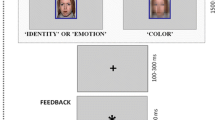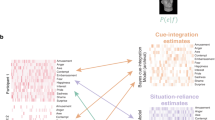Abstract
Theorists have argued that facial expressions of emotion serve the interpersonal function of allowing one animal to predict another's behavior. Humans may extend these predictions into the indefinite future, as in the case of trait inference. The hypothesis that facial expressions of emotion (e.g., anger, disgust, fear, happiness, and sadness) affect subjects' interpersonal trait inferences (e.g., dominance and affiliation) was tested in two experiments. Subjects rated the dispositional affiliation and dominance of target faces with either static or apparently moving expressions. They inferred high dominance and affiliation from happy expressions, high dominance and low affiliation from angry and disgusted expressions, and low dominance from fearful and sad expressions. The findings suggest that facial expressions of emotion convey not only a target's internal state, but also differentially convey interpersonal information, which could potentially seed trait inference.
Similar content being viewed by others
References
Ambady, N., & Rosenthal, R. (1993). Half a minute: Predicting teacher evaluations from thin slices of nonverbal behavior and physical attractiveness.Journal of Personality and Social Psychology, 64, 431–441.
Berry, D. S. (1991). Accuracy in social perception: Contributions of facial and vocal information.Journal of Personality and Social Psychology, 61, 298–307.
Borkenau, P., & Liebler, A. (1992). Trait inferences: Sources of validity at zero acquaintance.Journal of Personality and Social Psychology, 62, 645–657.
Buss, D. M., & Barnes, M. (1986). Preferences in mate selection.Journal of Personality and Social Psychology, 50, 559–570.
Buss, D. M., Gomes, M., Higgins, D. S., & Lauterbach, K. (1987). Tactics of manipulation.Journal of Personality and Social Psychology, 52, 1219–1229.
Darwin, C. (1962).The expression of the emotions in man and animals. London: John Murray (originally published in 1872).
Ekman, P. (1972). Universals and cultural differences in facial expressions of emotion. In J. Cole (Ed.),Nebraska Symposium on Motivation, 1971 (pp. 207–283). Lincoln, NE: University of Nebraska Press.
Ekman, P. (1979). About brows: Emotional and conversational signals. In M. von Cranach, W. Lepenies, & D. Ploog (Eds.),Human ethology (pp. 169–202). New York: Cambridge University Press.
Ekman, P. (Ed.). (1982).Emotion in the human face, 2nd ed., Cambridge, UK: Cambridge University Press.
Ekman, P. (1993). Facial expression and emotion.American Psychologist, 48, 384–392.
Ekman, P., & Friesen, W. V. (1975).Unmasking the face: A guide to recognizing emotions from facial cues. Englewood Cliffs, NJ: Prentice-Hall.
Ekman, P., & Friesen, W. V. (1976).Pictures of facial affect. Palo Alto, CA: Consulting Psychologists Press.
Ekman, P., Sorenson, E. R., & Friesen, W. V. (1969). Pan-cultural elements in facial displays of emotions.Science, 164, 86–88.
Field, T. (1994). The effects of mother's physical and emotional unavailability on emotion regulation.Monographs of the Society for Research on Child Development, 59, 208–227.
Frank, R. H. (1988).Passions within reason: The strategic role of the emotions. New York: Norton.
Freedman, M. B., Leary, T. F., Ossorio, A. G., & Coffey, H. S. (1951). The interpersonal dimension of personality.Journal of Personality, 20, 143–161.
Funder, D. C., & Sneed, C. D. (1993). Behavioral manifestations of personality: An ecological approach to judgmental accuracy.Journal of Personality and Social Psychology, 64, 479–490.
Gifford, R. (1991). Mapping nonverbal behavior on the interpersonal circle.Journal of Personality and Social Psychology, 61, 279–288.
Henley, N. M., & LaFrance, M. (1984). Gender as culture: Difference and dominance in nonverbal behavior. In A. Wolfgang (Ed.),Nonverbal behavior: Perspectives, applications, intercultural insights (pp. 351–371). Lewiston, NY: Hogrefe & Huber Publishers.
Horowitz, L. M., Rosenberg, S. E., Baer, B. A., Ureno, G., & Villasenor, V. S. (1988). Inventory of Interpersonal Problems: Psychometric properties and clinical applications.Journal of Consulting and Clinical Psychology, 56, 885–892.
Izard, C. E. (1972).Patterns of emotions: A new analysis of anxiety and depression. New York: Academic Press.
Keating, C. F., Mazur, A., & Segall, M. H. (1977). Facial gestures which influence the perception of status.Social Psychology Quarterly, 40, 374–378.
Keating, C. F., Mazur, A., Segall, M. H., Cysneiros, P. G., Divale, W. T., Kilbride, J. E., Komin, S., Leahy, P., Thurman, B., & Wirsing, R. (1981). Culture and the perception of social dominance from facial expression.Journal of Personality and Social Psychology, 40, 615–626.
Kenny, D. A., Horner, C., Kashy, D. A., & Chu, L. (1992). Consensus at zero acquaintance: Replication, behavioral cues, and stability.Journal of Personality and Social Psychology, 62, 88–97.
Knutson, B. (1993). “Neutral” faces differ in emotional impact. Unpublished manuscript.
Malatesta, C. Z., Fiore, M. J., & Messina, J. J. (1987). Affect, personality and facial expressive characteristics of older people.Psychology and Aging, 2, 64–69.
Matsumoto, D., & Kudoh, T. (1993). American-Japanese cultural differences in attributions of personality based on smiles.Journal of Nonverbal Behavior, 17, 231–243.
Plutchik, R. (1980).Emotion: A psychoevolutionary synthesis. New York: Harper & Row.
Russell, J. A. (1980). A circumplex model of affect.Journal of Personality and Social Psychology, 39, 1161–1178.
Russell, J. A., & Mehrabian, A. (1977). Evidence for a 3-factory theory of emotions.Journal of Research in Personality, 11, 273–294.
Schaefer, E. S., & Plutchik, R. (1966). Interrelationship of emotions, traits, and diagnostic constructs.Psychological Reports, 18, 399–410.
Scherer, K. R., Scherer, U., Hall, J. A., & Rosenthal, R. (1977). Differential attribution of personality on multi-channel presentation of verbal and nonverbal cues.Psychological Research, 39, 221–247.
Secord, P. F. (1958). Facial features and inference processes in interpersonal perception. In R. Taguiri & L. Petrullo (Eds.),Person Perception and Interpersonal Behavior (pp. 300–315). Stanford, CA: Stanford University Press.
Snyder, M., Tanke, E. D., & Berscheid, E. (1977). Social perception and interpersonal behavior: On the self-fulfilling nature of social stereotypes.Journal of Personality and Social Psychology, 35, 656–666.
Watson, D. (1989). Strangers' ratings of the five robust personality factors: Evidence of a surprising accuracy.Journal of Personality and Social Psychology, 57, 120–128.
Wiggins, J. S., & Pincus, A. L. (1992). Personality: Structure and assessment.Annual Review of Psychology, 43, 473–504.
Wiggins, J. S., Trapnell, P., & Phillips, N. (1988). Psychometric and geometric characteristics of the Revised Interpersonal Adjective Scales (IAS-R).Multivariate Behavioral Research, 23, 517–530.
Author information
Authors and Affiliations
Corresponding author
Additional information
This article constitutes a portion of my dissertation research at Stanford University, which was supported by a National Science Foundation Fellowship and an American Psychological Association Dissertation Award. Thanks to Nancy Alvarado, Chris Dryer, Paul Ekman, Bertram Malle, Susan Nolen-Hoeksema, Steven Sutton, Robert Zajonc, and more anonymous reviewers than I can count on one hand for their comments.
Rights and permissions
About this article
Cite this article
Knutson, B. Facial expressions of emotion influence interpersonal trait inferences. J Nonverbal Behav 20, 165–182 (1996). https://doi.org/10.1007/BF02281954
Issue Date:
DOI: https://doi.org/10.1007/BF02281954




